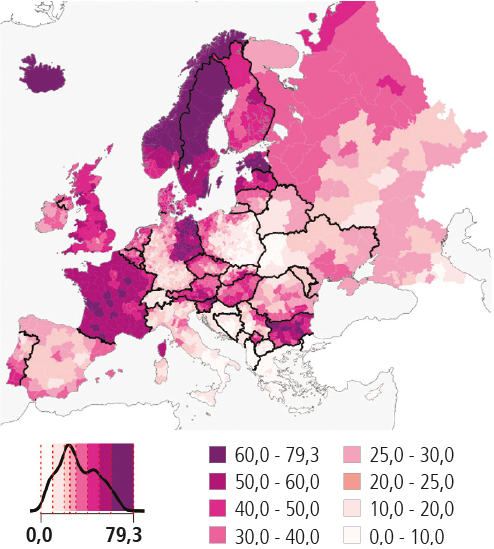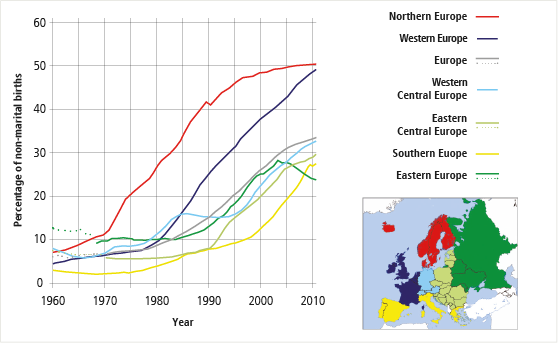April 20, 2016 | News | Demografische Forschung aus Erster Hand
Families unmarried
The Golden Age of Marriage in Europe had clear norms: In the 1950s and 1960s, people were expected to marry before having a child. But in many countries of today, more than half of the births are out of wedlock. A new study looks at this development spanning from 1910 to today.
(The following text is based on the original article Spatial variation in non-marital fertility across Europe in the twentieth and twenty-first centuries: recent trends, persistence of the past, and potential future pathways, by MPIDR researcher Sebastian Klüsener and has with minor changes also been published in the issue 1/2016 of the demographic quarterly Demografische Forschung Aus Erster Hand.)
A couple’s decision whether to marry before having a child can hinge on different factors: To tie the knot would make sense economically because family policies provide incentives for married couples, and a partner who works less hours or not at all would have greater financial security. Religious motives or social norms and traditions can affect the decision, too. And so does the availability and acceptance of contraception as it can have an impact on unplanned non-marital birth. Many of these reasons applied to the heyday of the traditional family, i.e., the mid-20th century: More than 90 percent of all births occurred within marriage (see Fig. 1). At that time, non-marital was associated with significant disadvantages – for the child as well as the mother. The predominance of birth within marriage was observed throughout Europe but has become the exception over the last 100 years, as shown by a study conducted by Sebastian Klüsener of the Max Planck Institute for Demographic Research.

Fig. 1: From the Golden Age of Marriage to today: The development of non-marital birth from 1960 to 2010 in different parts of Europe. © Statistical Offices, Eurostat, UN Statistical Yearbook, Europarat (2005), Decroly and Vanlaer (1991). Atlas de la population européenne. Brussels: Editions de l’Université de Bruxelles
The significance of marriage slowly started to decline as early as in 1970, a process linked to the advance of secularization in many countries and gains made in the economic independence of women in many places. Northern Europe is the forerunner of this development: By 1990, the share of unmarried births had already increased fourfold, whereas in Western and Central Europe it had started to grow significantly as late as in 1980 and in Southern and Eastern Europe only after 1990.
In Northern Europe, the increase already seems to have reached its peak. In Western Europe, by contrast, the share of non-marital births has continued to rise in recent years. In many parts of Northern and Western Europe, there are already more births out of wedlock than births within marriage (cf. Fig. 2). In these countries, the suburban belts around large cities seem to be the last strongholds of the traditional family, as Klüsener has shown by the example of Denmark. People who favor alternative lifestyles often are prevalent in the inner-city areas, but the suburban belts with its access to well-paid jobs in the city and low housing prices seem to attract families that have more traditional ideas.

Fig 2: The percentage of non-marital births in 2007 in different regions of Europe. © Statistical Offices, Eurostat, own calculations
Eastern Europe, a region comprising non-EU countries on former Soviet Union territory, is an interesting deviation from the general trend. In 1960, this part of Europe had the highest proportion of births outside marriage. Today it has the lowest. Eastern Europe currently is also the only European region where the trend is declining. Klüsener comes up with several possible reasons: The economic situation has improved significantly compared to the 1990s, possibly leading to reduced marriage postponement. Eastern Europe is also one of the few regions of Europe where religion is gaining in importance and old traditions are returning. These traditions seem to have disappeared under the strong influence of the Soviet state.
Using methods of spatial analysis, Sebastian Klüsener has shown in his study that regional variations in the share of non-marital births can persist for long in many European regions. Scandinavia, for example, had a very high proportion of unmarried births as early as 100 years ago. As to Germany, strong East-West differences existed well before the division of Germany after 1945, thus they cannot be attributed to that division alone.
Klüsener assumes that despite these variations within and between individual nations, the conditions within the European Union will continue to converge over time with continuing European integration. The variations between EU countries and Eastern European non-EU countries, however, could persist for a longer.
More Information